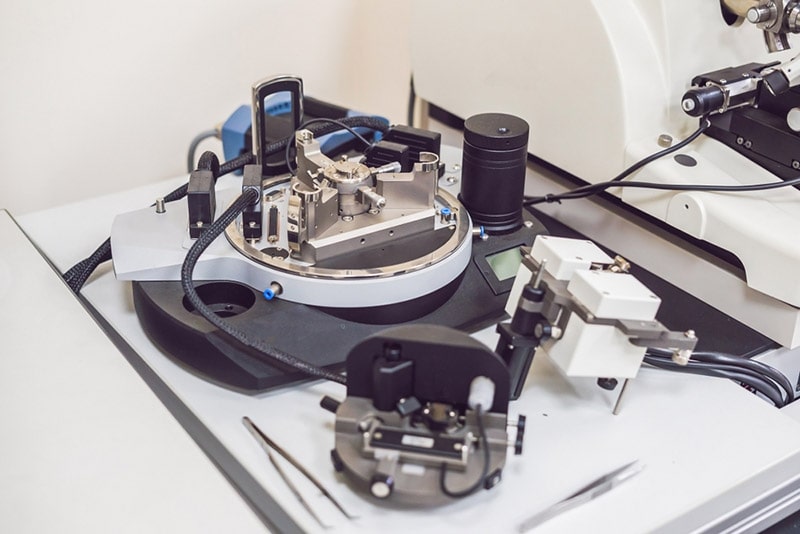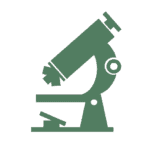What Is Atomic Force Microscopy Used For? The Fascinating Answer!
Last Updated on

If you’re diving into scientific articles, one term that you might see is atomic force microscopy. But what exactly is this type of microscope, who uses it, and what is it even for? Well, scientists use atomic force microscopy for probing the mechanical properties of cells and extracellular matrices.
We will answer this question and more, but just know beforehand that it’s a complex topic!

How Does It Work?
We’re not going to pretend that understanding the ins and outs of atomic force microscopy is easy because it’s not. It involves raster-scanning, micro-probe tips, piezoelectric elements, and many electronics to process the data.
But the simplified version is that a laser shines a light at a probe, and the probe reflects the light up to a photodiode, which measures the probe’s position depending on the angle that the light comes back.
We do need to emphasize that this is an oversimplified definition of how atomic force microscopy works. That said, it’s enough for most people, and unless you plan on getting into the field, it’s all you need to know.


What Are the Different Types of Atomic Force Microscopy?
There are two different “types” of atomic force microscopy, but it’s more about the different operating modes. Most atomic force microscopy devices can operate in either mode, it depends on the application for which way makes more sense.
The two operating modes are “contact mode” and “tapping mode.” Contact mode occurs when the sharp tip of the probe constantly makes contact with the surface. This mode gives the most detailed results, but it also wears out the tip faster, and it can be challenging to maintain constant contact in extremely rugged terrain.
Tapping mode uses an oscillating motion with the probe, which makes contact with the surface at the bottom of the oscillation. The exact number of taps depends on the setting, affecting both the speed of oscillation and the final accuracy of the results.
While tapping mode is easier to execute and generally gives you accurate results, it can miss short spikes or dips, and in rare circumstances, those can be significant.
Again, the best mode depends on the specific application, and most devices can use both, though the tip of the probe is generally changed out depending on the mode used.

Where Is It Used?
When you think of how atomic force microscopy works, you might think that it has geological applications for measuring topography, but it actually doesn’t work well for applications that large.
Instead, it’s a better choice for soft biological materials. But while it has a limited range of uses, it’s incredibly beneficial to those niche career fields.
Furthermore, scientists use atomic force microscopy for probing the mechanical properties of cells and extracellular matrices. It works wonders for extremely small objects and can give extremely precise results.
https://www.instagram.com/p/CXOgMP4MEJf/

Advantages of Atomic Force Microscopy
The advantage of atomic force microscopy is that it can give you exact measurements of objects that are too small to measure with traditional tools. Not only does it work to measure otherwise impossibly small objects, but it can also give a level of preciseness that you can’t get through other methods.
It’s also minimally invasive. This is important because you need a tool that won’t change the measurements of the objects that you’re trying to measure by pressing too hard on them or altering them in another way.

Disadvantages of Atomic Force Microscopy
While atomic force microscopy is an excellent tool for a few specific applications, the most notable disadvantage of atomic force microscopy is its lack of general applications. It doesn’t work for large areas. In fact, it’s not the best possible choice for non-microscopic surfaces.
Since it only has a limited range of applications, it’s useless as a measuring device for most everyday objects.
https://www.instagram.com/p/CL9fq4LKVYt/

FAQs
It’s only natural to have questions about atomic force microscopy after learning about it. While we can’t answer every potential question out there, we address a few of the most common ones here.
What Is the Difference Between SEM & AFM?
Scanning electron microscopes (SEM) is a method that scientists use to measure the topography of objects. However, while atomic force microscopes (AFM) produce a three-dimensional image of an object, SEM microscopes produce a two-dimensional image.
What Is the Resolution of AFM?
The entire point of an AFM is to get an accurate topography of an extremely small object, but just how accurate is this device? It all comes down to the exact machine and method used, but it’s typically extremely accurate.
It can give a lateral accuracy of 1 to 5 nm. An nm is a nanometer, and it’s equivalent to one billionth of a meter. The height measurement of an AFM is even more accurate, up to 1 Å, which works out to one ten-billionth of a meter or a hundred-millionth of a centimeter.
Which Laser Does AFM Use?
Most AFMs use a simple diode laser. It’s a type of laser that produces light through a semiconductor with an electrical current, and it’s a low-cost part of the AFM.
Who Invented AFM?
While AFM is a complex tool, it’s been around for quite a while. Three different scientists named Binnig, Quate, and Gerber developed the atomic force microscope in 1985, and it’s been a useful tool at scientists’ disposal ever since.

A Quick Reference Guide
- When measuring microscope elements
- When you need precise topographic measurements
- When measuring large objects
- When you need anything but topography

Conclusion
While atomic force microscopes are complex tools, they are also invaluable to the scientific community. They help us understand the exact size and dimensions of microscopic objects, which has led to further refinement of our knowledge of these miniature objects and how they interact with the world around them.
So, while you probably don’t need an atomic force microscope in your home, it is a good thing that scientists have them in their labs!
Featured Image Credit: Elizaveta Galitckaia, Shutterstock
About the Author Robert Sparks
Robert’s obsession with all things optical started early in life, when his optician father would bring home prototypes for Robert to play with. Nowadays, Robert is dedicated to helping others find the right optics for their needs. His hobbies include astronomy, astrophysics, and model building. Originally from Newark, NJ, he resides in Santa Fe, New Mexico, where the nighttime skies are filled with glittering stars.
Related Articles:
What Is the Best Binocular Magnification for Hunting? Optical Features Explained
How to Clean a Refractor Telescope: Step-by-Step Guide
How to Clean a Telescope Eyepiece: Step-by-Step Guide
How to Clean a Rifle Scope: 8 Expert Tips
Monocular vs Telescope: Differences Explained (With Pictures)
What Is a Monocular Used For? 8 Common Functions
How to Clean a Telescope Mirror: 8 Expert Tips
Brightfield vs Phase Contrast Microscopy: The Differences Explained
